Describe the structural components of the TCR complex and their respective functions.
Though we will mostly discuss T cells that have alpha/beta TCRs, understand that some T cells have a TCR consisting of gamma and delta proteins.
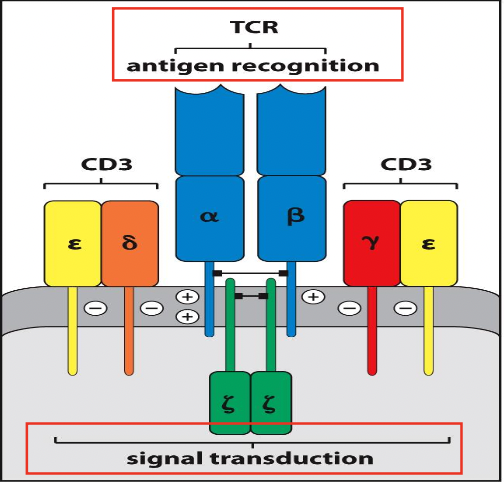
TCR- T cell Receptor
TCR Complex:
- Structure: has CD3 alpha and beta chain
- CD3 ( 6 protein complex) ; handles the signal transduction
- CD3 and TCell together are the TCR
Structure:
- Alpha chain and beta chain are the receptor pieces but can't perform signal transduction alone
Functions:
- The alpha and beta chain of the TCR are responsible for binding to MHC/peptide complexes
- CD3: the components are responsible for cellular signaling
Explain the differences between antibody and TCR with respect to isotypes, secreted vs. nonsecreted complexes, affinity maturation, binding of free antigen.
- TCRs are never secreted from the cell.
- TCRs do not exist in different isotypes (no class-switching)
- TCRs do not change their affinity during clonal expansion (no somatic hypermutation or affinity maturation).
- TCRs do not bind free antigen (MHC presentation)
Describe the structural similarities between a Fab of an immunoglobulin and a TCR (immunoglobulin domains, variable and constant domains, CDRs etc.).
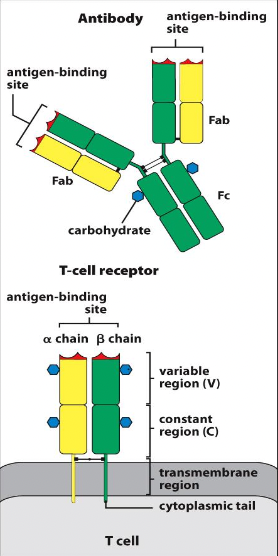
Similarities
- They have variable domains and constant domains, and 2 Chains (in this case, alpha and beta)
- 3 CDR loops on each of the chains
Some significant differences between Abs and TCRs:
- TCRs are never secreted from the cell.
- TCRs do not exist in different isotypes (no class-switching).
- TCRs do not change their affinity during clonal expansion (no somatic hypermutation or affinity maturation).
- TCRs do not bind free antigen (MHC presentation).
Explain the process of VDJ recombination (somatic recombination) in the T cell receptor genes. (Essentially similar to VDJ recombination of immunoglobulin genes).
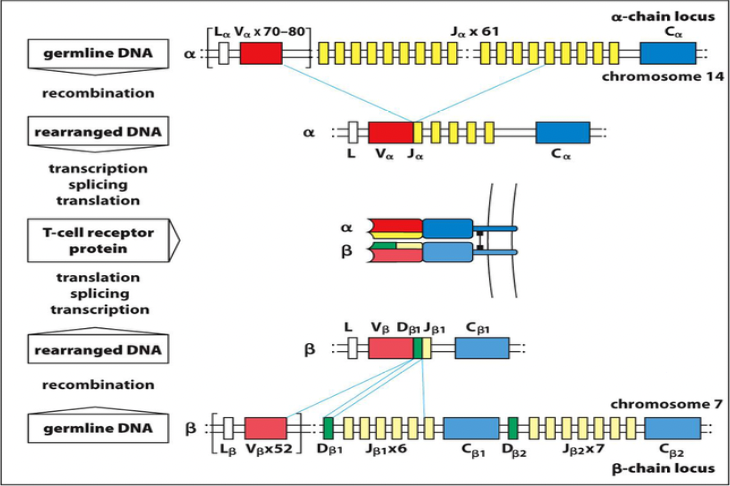
- Random VDJ recombination.
- VDJ recombinase (RAG enzyme).
- RSS sequences flank V, D, J regions.
- 1-turn/2-turn rule is followed.
- P and N nucleotide addition occurs.
Explain the multiple processes that contribute to generating TCR diversity.(Same as for antibodies, except that there is no somatic hypermutation of the TCR genes).

Processes: RAG-mediated VDJ recombination during development in thymus
- Random VDJ recombination.
VDJ recombinase (RAG enzyme).
RSS sequences flank V, D, J regions.
1-turn/2-turn rule is followed.
P and N nucleotide addition occurs.
Describe the nature of the physical aspects and chemical interactions that account for TCR binding to MHC/peptide complexes (CDRs/non-covalent interactions).
- T-cells bind only to a specific antigenic peptide bound to a specific MHC they are specific like B cells
Explain what MHC restriction means.
What does it really mean to say that T cells are MHC restricted?
MHC Restriction means:
- they bind their antigen only when presented by the correct MHC molecule
- A single TCR is specific for both an antigenic peptide and self molecule
Correctly identify and describe the properties of a type of T cell that is MHC-I restricted (Tc).
Correctly identify and describe the properties of a type of T cell
that is MHC-
II restricted (Th).
MHC-1
- Cytotoxic T cells recognize antigens presented by MHC class I molecules and are involved in the killing infected cells
MHC-2
- T-helper cells recognize antigens presented by MHC class II molecules and help coordinate and regulate the immune response
Which one of the following is not expressed by both Tc and TH cells?
a.)B2-microglobulin
b.)TCR
c.)TAP transporter
d.)CD8
e.)CD3
d.) CD8
The T cells of mouse X cannot produce a functional CD3 complex. True/False: The TH cells of mouse X are unable to bind to MHC-II/peptide complexes present on the surface of a dendritic cell.
False
The SCID mouse (Severe Combined Immuno-Deficiency) lacks a functional RAG enzyme complex (fact). True/False: SCID mice do not possess functional T cells or functional B cells.
True
The RAG enzyme complex recombines the immunoglobulin genes in developing B cells and it recombines the TCR genes in developing T cells (fact). Talk with a classmate and see if you can propose a reason for why the RAG enzyme does not recombine the immunoglobulin genes of T cells or the TCR genes of B cells (the 1-turn and 2-turn RSS sequences are identical).
-----
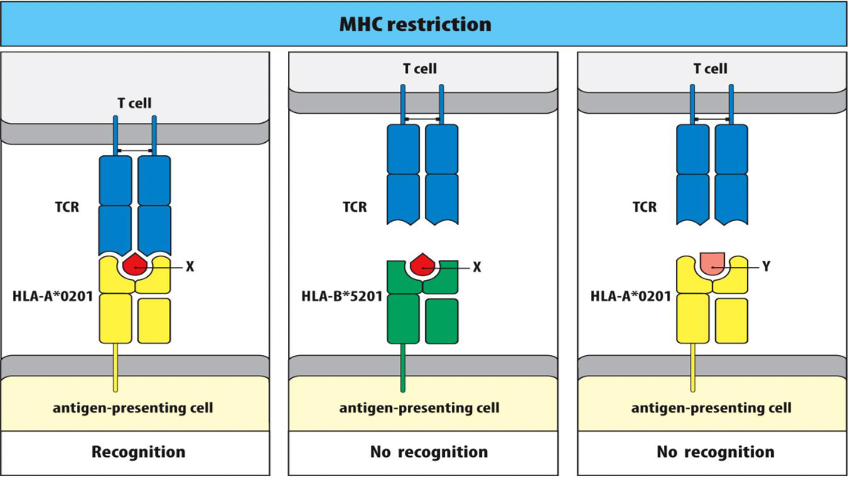
The image below shows a T cell interacting with an APC in the body of person X. Which one of the following statements about the image is false?
a.)The peptides being presented could have been derived from a polyubiquitinated virus protein.
b.)The T cell shown in the image expresses CD8.
c.)The MHC shown in the center image (B*5201) was at one time bound by a protein called the invariant chain.
d.)The T cell shown in the image would be expected to express HLA-A0201 and HLA-B5201 even though the image does not show this.
e.)This individual most likely possesses other T cells that could bind to the HLA-A*0201/peptide Y complex (far right image).
c.)The MHC shown in the center image (B*5201) was at one time bound by a protein called the invariant chain.
A bacteria enters the body and drains into a lymph node through an afferent lymphatic vessel. After entering the lymph node this bacterial cell makes contact with many different B cells and with many different T cells. True/False: It is equally likely that this bacteria will be bound by one or more B lymphocyte as it is to be bound by one or more T lymphocytes.
False
It is not possible for Tcells to bind to bacteria.
True/False: It is possible for the TCR on a CTL to bind to a MHC-I/peptide complex on the surface of a TH.
True
The TCR of a Tc binds with high affinity to a MHC-I/peptide complex presented on the surface of a virus-infected DC, but the Tc does not become activated by this encounter. Which one of the following cellular defects is most likely to be responsible for this lack of activation?
a.) The Tc lacks a functional B2 microglobulin gene.
b.) The DC lacks any functional PAMP receptors.
c.) The TCR of the Tc lacks functional CDRs.
d.) The TCR lacks a functional CD3 complex.
e.) The DC lacks a functional TAP transporter.
d.) The TCR lacks a functional CD3 complex.
True/False: It is possible to determine if a single T cell is TH or is a TC simply by analyzing the structure of the TCR that the cell expresses.
False
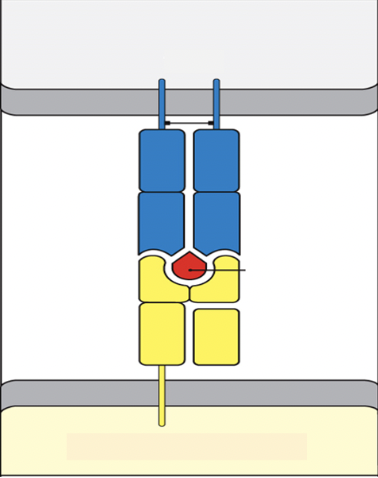
Which one of the following statements is true?
a.)The interaction shown will initiate a signal transduction pathway within the cell shown in the top part of the image.
b.)The interaction shown will initiate a signal transduction pathway within the cell shown in the bottom part of the image.
a.)The interaction shown will initiate a signal transduction pathway within the cell shown in the top part of the image.